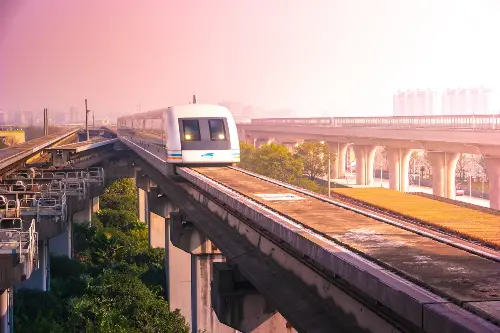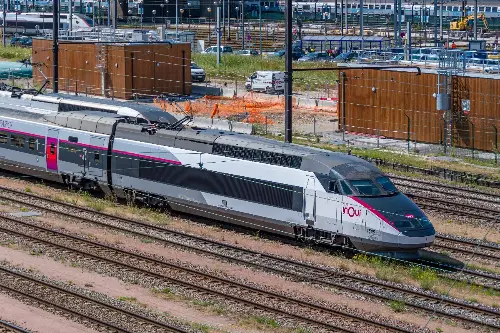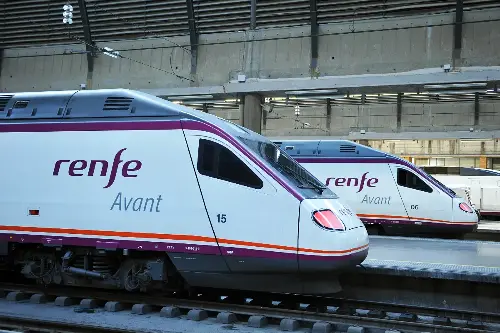As our world becomes increasingly fast-paced, the quest for speed has captured the imagination of engineers and travellers alike. The latest frontier in high-speed travel? Trains that surpass the velocity of traditional rail and bring new meaning to the term “rapid transit.” Let’s embark on a journey to meet the five fastest high-speed trains which are revolutionising rail travel worldwide.
The Reigning Champion: Shanghai Maglev

Since its inauguration in 2004, the Shanghai Maglev Train has continued to captivate with its breathtaking speed, silent flight on tracks, and technological prowess. Propelled by powerful magnetic levitation, this veritable king of trains travels the 30-kilometre distance from Shanghai’s Pudong International Airport to the city centre in a mere 7.5 minutes, reaching dizzying speeds of up to 431 km/h. Not only is the Maglev the world’s fastest train in commercial service, but it also holds the promise of magnetically-propelled future rail travel.
A Contender from the Land of the Rising Sun: The Shinkansen

Steeping in tradition yet always at the forefront of innovation, Japan’s Shinkansen, popularly known as the Bullet Train, rightfully earns its place on this list. With a track record of excellence since 1964 and regular speeds of 320 km/h, these sleek marvels are not just about speed; they are also paragons of punctuality and safety. The Shinkansen has become a cultural icon, a symbol of the efficiency and the drive for perfection that defines its homeland. The upcoming Chuo Shinkansen, employing maglev technology similar to Shanghai's, aims to push the envelope further by promising speeds of over 500 km/h once operational.
Europe’s Standard Bearer: The TGV Duplex

France's TGV (Train à Grande Vitesse) has been a torch-bearer in the European high-speed rail movement since the early 1980s. The third-generation TGV Duplex trains combine both speed and style, seamlessly cutting through the French countryside at speeds of up to 320 km/h. Their bi-level design caters to more passengers while maintaining a low-centre of gravity, superior aerodynamics, and offering panoramic views of the scenic landscapes of France and beyond.
The Pride of Spain: The AVE Class 103

Whisking passengers between Madrid and Barcelona in just under three hours, the Spanish AVE (Alta Velocidad Española) trains are the epitome of high-speed luxury with a dash of Mediterranean flair. The AVE Class 103, specifically, clocks in at speeds of up to 310 km/h. A testament to Spain's commitment to high-speed rail infrastructure, the AVE network serves as a model for connecting urban hubs with efficiency and environmental consciousness.
Italy’s Swift and Stylish Arrow: The AGV Italo

Wrapping up our list is Italy’s AGV Italo, the first train in the world to utilise a distributed traction system, allowing for greater capacity and reduced lifecycle costs. Gliding across the Italian landscape at speeds of up to 300 km/h, the AGV Italo is not only fast but also uniquely Italian with its sleek design, luxurious interiors, and a culinary experience that pays homage to the country’s rich gastronomic heritage. The Italo strikes a fine balance between speed, comfort, and style, marking a new era for the Italian railways.
A Greener Future on Fast Tracks
While these trains boast jaw-dropping speeds that differ in their technical approaches, they share a unified vision: to make rail travel a competitive and greener alternative to air and road travel. The reduction in travel times makes high-speed trains an increasingly appealing option for commuting and travel, while their energy efficiency and lower carbon footprint align with global efforts to combat climate change.
Moreover, the development of these high-speed rail services redefines the way we understand distances and regional connectivity. They enable greater mobility, foster economic growth, and bridge cities, making them more accessible than ever before. As high-speed rail networks expand and innovate, they promise a future where high-speed rail travel is not just a novelty but the norm, propelling us into an age of sustainable and hyper-connectivity.
In the race to revolutionise rail travel, these five trains stand as benchmarks of engineering excellence and ecological responsibility. They beckon adventurers and commuters alike to imagine a world where we need not sacrifice time for comfort or efficiency for environmental stewardship. The future of rail travel is here, bridging distances at unbelievable speeds and redefining the essence of journeying across our blue planet.